New products at Crocus
by Sarah - July 11th, 2010.Filed under: Crocus, New Products.
New lines added today at Crocus
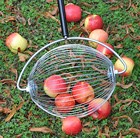
apple-wizard-for-collecting-eating-&-cooking-apples £59.99
The Large Apple Wizard is perfect for collecting windfall apples It will easily hold up to 10 apples and as emptying takes less that a second, you can quickly collect a very large number of them.Apple Wizard is a fruit picker that lets you enjoy your apple picking activities and still maintain proper posture. When using the Apple Wizard, you just walk as you normally would, guide the apple picker where the apples are and see how it picks them up efficiently and bruise-free! No No more struggling over apples, just let the good times roll.Also great at picking up tennis balls!

rose New Dawn (climbing) £11.99
Position: full sun or partial shadeSoil: fertile, humus-rich, moist, well-drained soil, including clayRate of growth: fast-growingFlowering period: July to SeptemberFlower colour: pale pearl-pinkHardiness: fully hardySprays of cup-shaped, double, fragrant, pale pearl-pink flowers from July to September and shiny, mid-green leaves. This lovely, repeat-flowering, climbing rose flourishes in both sun and partial shade. One of the best and most vigorous climbing roses, it’s perfect for covering a house or garden wall.Garden care: Before planting shorten thick roots to 25cm (10in) and reduce top-growth to an outward-facing bud 8-15cm (3-6in) above ground-level. Plant during a frost-free spell, incorporating well-rotted organic matter and a balanced fertiliser into the planting hole. Ensure that the ‘bud union’ (the bulge at the base of the shoots) is 2.5cm (1in) below the soil.All our roses are field grown. In October/November they are dug up and potted. However, they will not produce any new roots until spring, so don’t be surprised if the compost falls away from the roots when winter planting. Some suppliers send out ‘bare root’ plants unpotted, but we don’t as it is easier to manage them on the nursery in pots.

bearded iris £8.99
Position: full sunSoil: well-drained, moderately fertile soilRate of growth: averageFlowering period: May and JuneHardiness: fully hardyA really arresting sight in May and June, when the violet flowers and cornflower-blue beards appear among sword-shaped, grey-green leaves. This may not be one of the fanciest irises around, but what it lacks in originality it makes up in quantity, flowering prolifically throughout early summer.Garden care: Bearded irises prefer full sun and neutral-alkaline soil but if you have acidic or peaty soils you can top dress with lime before planting for good results. Plant shallowly with the upper part of the rhizome sitting on the surface of the soil, incorporating a low nitrogen fertiliser in the planting hole. After planting remove the upper-most third of the leaves to protect against wind-rock. In exposed areas stake with bamboo canes in early spring. Divide and replant about every three years.
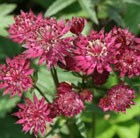
masterwort £7.99
Position: full sun or partial shadeSoil: fertile, moist, preferably humus-rich soilRate of Growth: average to fastFlowering period: June to AugustHardiness: fully hardyThis astrantia has stunning ruby-red pincushion flowers with a suggestion of white at the base of each petal. The leaves are pretty too; deeply lobed and mid green. This old cottage garden favourite has been enjoying a resurgence of interest in recent years, as it works equally well in contemporary style plantings. Use towards the front of a sunny, yet moist border, where the intense flower colour can be fully appreciated. Astrantias have been cultivated in Britain since the 16th century and have numerous common names, such as melancholy gentleman, Hattie’s pincushion and the more well-known masterwort.Garden care: Astrantias do not like to dry out. Incorporate plenty of organic matter when planting and water well in dry weather especially newly established plants. Lift and divide large clumps in early spring and apply a generous 5-7 cm mulch of well-rotted manure or garden compost around the plant. Divided specimens may take some time to establish since they don’t like having their roots disturbed.
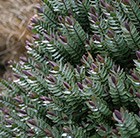
shrubby veronica £7.99
Position: full sun or partial shadeSoil: poor or moderately fertile, moist, well-drained neutral to slightly alkaline soilRate of growth: averageFlowering period: June and JulyHardiness: frost hardy (needs winter protection in cold areas)Lilac-blue summer flowers appear on short spikes, fading to white, among grey-green leaves with narrow red margins and veining when young. This small, spreading, evergreen shrub makes an attractive low, informal hedge or edging plant for a mixed border. In an urban or coastal site, it needs protection from cold, drying winds.Garden care: Needs minimal pruning. Remove misplaced or frost damaged branches in late spring.
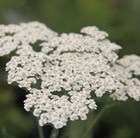
yarrow £7.99
Position: full sunSoil: well-drained, including dryRate of Growth: averageFlowering period: August to OctoberHardiness: fully hardyFlowering later than many other yarrows, this one has the same attractive grey-green foliage, from which upright stems emerge bearing flattened heads of pale yellow flowers, which turn to milky white as they mature. After they have faded, the developing seedheads create an attractive silhouette, which remains interesting well into winter if you don’t cut it back. A good mixer with other late perennials such as Asters, it also works really well with ornamental grasses.Garden care: Stake using bamboo canes or brushwood before the flowers appear. Cut down to the ground in late winter, but resist the urge to do this earlier, as the seed heads look lovely in the winter light. Lift and divide large clumps in late autumn or early spring.
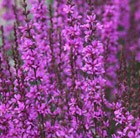
loosestrife £6.99
Position: full sunSoil: fertile, deep, moist soilRate of Growth: average to fastFlowering period: June to AugustFlowers: purple-redOther features: attracts wildlife Hardiness: fully hardyIntense purple-red flowers appear on tall flower spikes from early summer above lance-shaped foliage. This is a spectacularly colourful plant for watersides, pond banks and woodland borders where the soil is reliably moist. It is a clump forming perennial that attracts butterflies, birds and bees to their nectar.Garden Care: It self-seeds freely, so if you want to control its spread remove the flowerspikes as they fade.
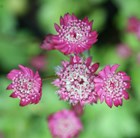
masterwort £6.49
Position: full sun or partial shadeSoil: fertile, moist, preferably humus-rich soilRate of growth: average to fastFlowering period: June to AugustHardiness: fully hardySmall, papery, plum-coloured, pincushion-like flowers surrounded by a ruff of wine-tinted bracts, are produced from June to August above deeply lobed, dark green leaves. Although it is an old cottage-garden favourite, this astrantia works equally well in contemporary-style plantings. Use it towards the front of a sunny, yet moist border. Astrantias do not like dry soil. The faded blooms are best cut back close to the ground to prolong flowering. Astrantias have been cultivated in Britainsince the 16th century and have numerous common names, such as melancholy gentleman, Hatties pincushion and the more well known masterwort.Garden care: Incorporate plenty of organic matter when planting and water well in dry weather especially newly established plants. Lift and divide large clumps in early spring and apply a generous 5-7 cm mulch of well-rotted manure or garden compost around the plant. Divided specimens may take some time to establish since they dont like having their roots disturbed.






